Panasonic TX-55JZ2000 Review
High-end OLED thrills with Panasonic's latest


Verdict
The Panasonic JZ2000 is a gorgeous high-end OLED TV that doesn’t just thrill with movies, but plays nice with next-gen games consoles, too, thanks to 4K 120fps support and VRR. Its pro-style OLED panel is still class-leading, and a new AI processor makes getting great results easier than ever. Frustratingly expensive it may be, but it’s undeniably fabulous too.
Pros
- Delicious, dynamic imagery
- Dolby Vision IQ, HDR10+ Adaptive support
- 360-degree Soundscape Pro audio system
- 4K/120fps HDMI inputs
Cons
- Pricey
- Sound system may be unnecessary for AV fans
Key Features
- Dolby Vision IQ, HDR10+ Adaptive, HDR10, HLG, HLG PhotoSupports all of the HDR formats currently available
- Filmmaker modeFilmmaker mode offers the TV’s most accurate picture mode
- 125W Dolby Atmos sound systemBuilt-in Atmos system capable of firing sound above and to the sides
Introduction
With the JZ2000, Panasonic has partnered its Master HDR OLED Professional Edition panel with an all-new AI processor – and with spectacular results. Then, for good measure, it’s added extra side speakers to its Dolby Atmos sound system for even greater immersion. You may never feel the need to go to the cinema again…
The JZ2000 is the latest Panasonic flagship to be built around its Master HDR OLED Professional Edition panel, which has been engineered to deliver a higher average picture level than regulation OLED screens.
It’s an update on the HZ2000, and looks much like its predecessor. It has the same dark grey livery, Technics-branded front-facing speaker bar, and upfiring Dolby Atmos height speakers mounted high on the back panel.
But make no mistake, this is a significantly upgraded model, with a number of distinguishing features. Finally, there’s support 4K 120FPS gaming, courtesy of HDMI 2.1, and it also boasts the first big AI upgrade for Panasonic’s tinsel-town inflected HCX processor.
Availability
- UKRRP: £2699
- USAunavailable
- EuropeRRP: €2999
- Canadaunavailable
- Australiaunavailable
The Panasonic JZ2000 comes in 55- and 65-inch screen sizes, the TX-55JZ2000 and TX-65JZ2000. We have the smaller of the two on test. They’re priced at £2699 and £3499 respectively, which puts them in low earth orbit (the kind of place you’ll find Branson and Bezos) when it comes to affordability.
There’s no North American equivalent to the JZ2000, as Panasonic pulled out of the TV market stateside some time ago.
Design
- Built-in Dolby Atmos sound system
- Swivel pedestal stand
- Premium remote control
Considering just how many speakers are built into the Panasonic JZ2000’s cabinet, it’s remarkable that this set looks as svelte as it does. The gun-metal grey bezel is almost inconsequential, effortlessly blending with the forward-facing speaker array. In addition to the upward-firing height speakers on the rear panel, there are now two matching side-firing enclosures, too. Panasonic dubs this new seven-channel configuration 360º Soundscape Pro.
Connectivity is a step up from last year’s Panasonic models. Two of the four HDMI inputs are v2.1-enabled for High Frame Rate 4K/120HZ video. There’s also eARC, VRR (Variable Refresh Rate) and ALLM (Auto Low Latency Mode) Game mode support.
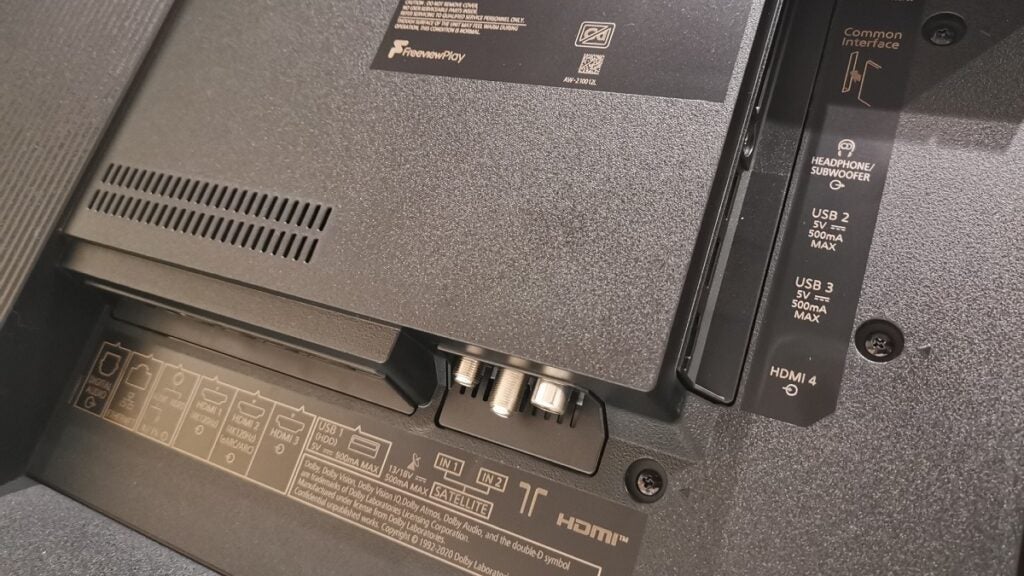
In addition, there’s a trio of USB ports, a digital optical audio output and Ethernet to back-up Wi-Fi and Bluetooth. The latter now supports dual connectivity, so you can partner up for private listening late at night.
The screen sits on a neat circular pedestal stand with swivel action, so you can tweak the angle of view to suit your seating arrangements.
The remote handset is festooned with buttons, including shortcuts for Netflix, Rakuten TV and Prime Video, but it’s nicely finished with a brushed metal effect, and feels good to wield.
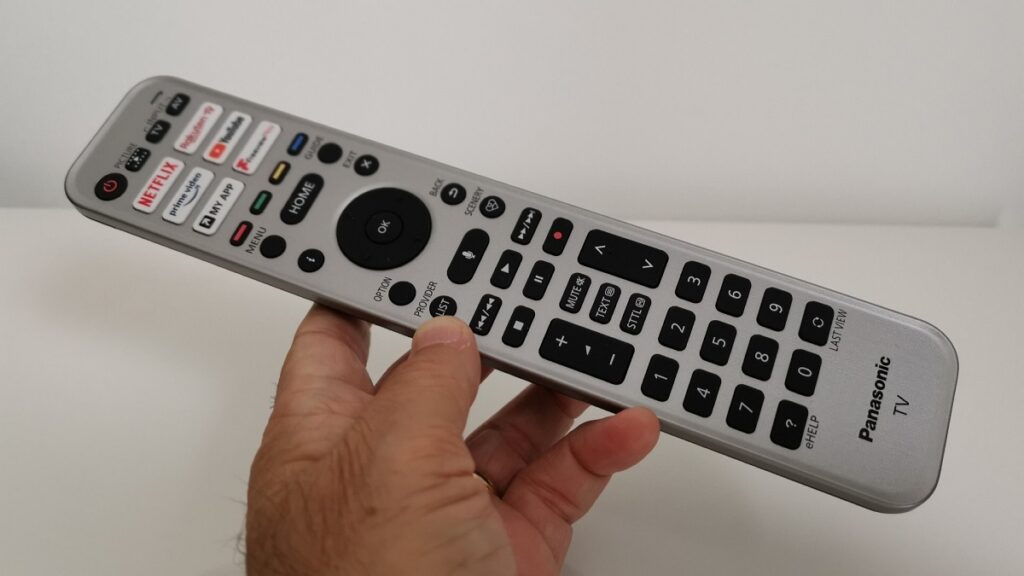
Features
- Improved My Home Screen smart platform
- Low input lag
- Freeview Play for catch-up and boxsets
While Panasonic has opted for Android on some of its lower-end models, its proprietary My Home Screen remains in place here, now in its 6.0 incarnation. The good news is the brand has dramatically improved the user experience.
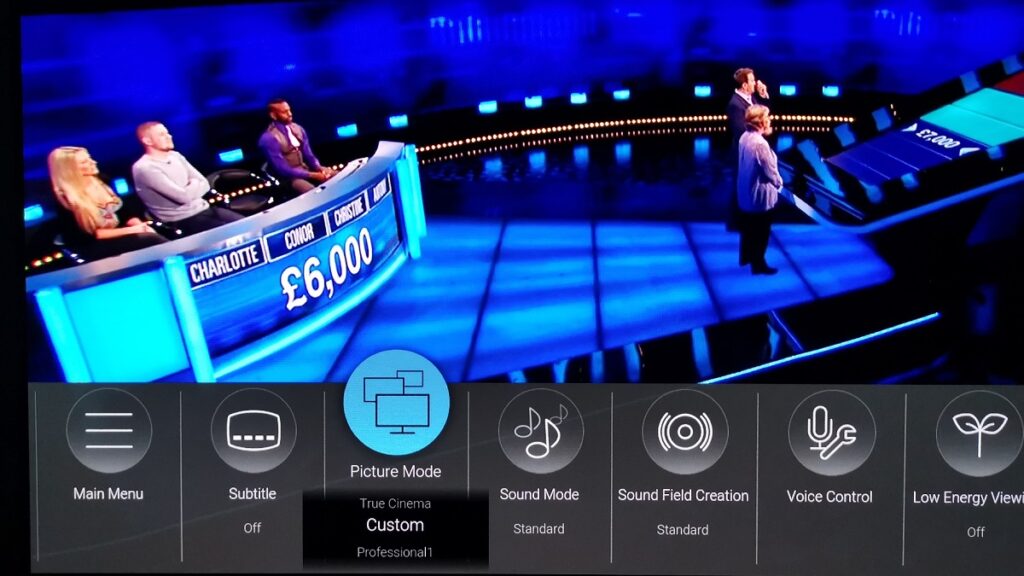
It still launches with customisable Home buttons, but there’s greatly enhanced menu navigation and content curation. A My Scenery Gallery doesn’t just run JPEGs; it also has the option of gently moving videos, such as a star field for when you’re feeling particularly chilled.
Naturally, there’s voice control with Google Assistant and Alexa, too.
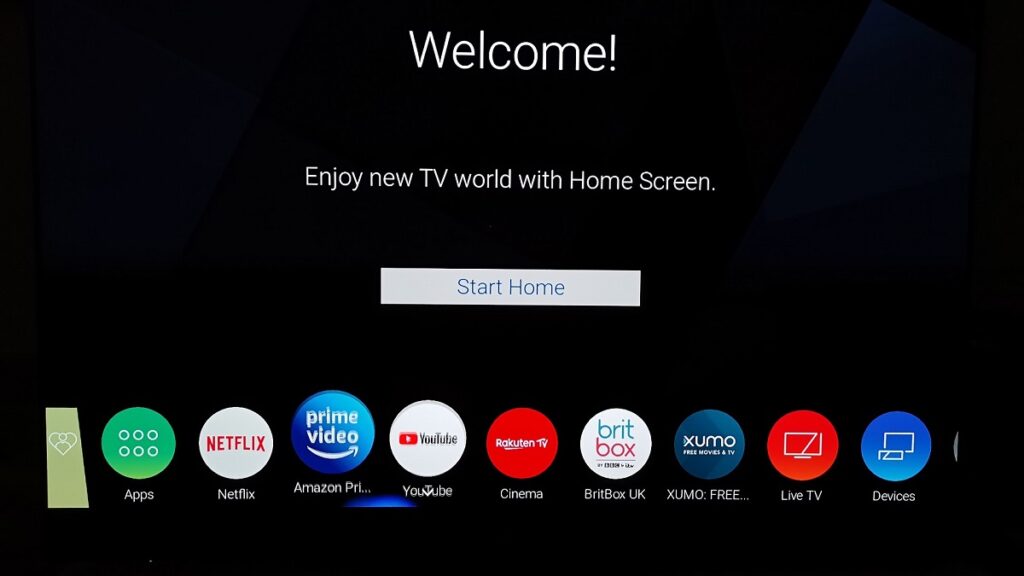
The set also comes with Freeview Play, which guarantees all your mainstream catch-up TV needs will be covered (BBC iPlayer, ITV Hub, All4, My5, UKTV Play and so on). This opens the door to a huge selection of boxsets, too.
The streaming app selection covers Netflix, Amazon Prime, BritBox, Rakuten TV, and it’s been updated to support Disney+ and Apple TV+.
Input lag is on the right side of winning. We measured it at 14.5ms (1080/60), which is more than good enough to keep keen gamers alive longer.
Picture quality
- All-new HCX Pro AI processor
- Master HDR OLED Professional Edition
The big new deal on the JZ2000 is AI processing. Panasonic has lagged behind rivals when it comes to AI and deep learning, but this year its HCX processor graduates with honours. The level of fine detail and sublime colour gradation this new silicon delivers is thrilling. HD upscaling is also first-class.
You won’t need to do much to see this set look its best, either. An Auto AI mode does most of the heavy-lifting, auto-optimising both sound and vision to match whatever you’re watching.
Panasonic goes all out when it comes to HDR compliance. There’s Dolby Vision IQ and HDR10+ Adaptive, both of which use an onboard sensor to adjust the image based on ambient lighting conditions.
Panasonic has made it clear to us that it isn’t sourcing a variant of LG Display’s Evo panel here, and is instead following the path taken on previous panel iterations. This seems a wise move, since this panel more than holds its own, offering brighter, intense peak HDR highlights than its LG rival.
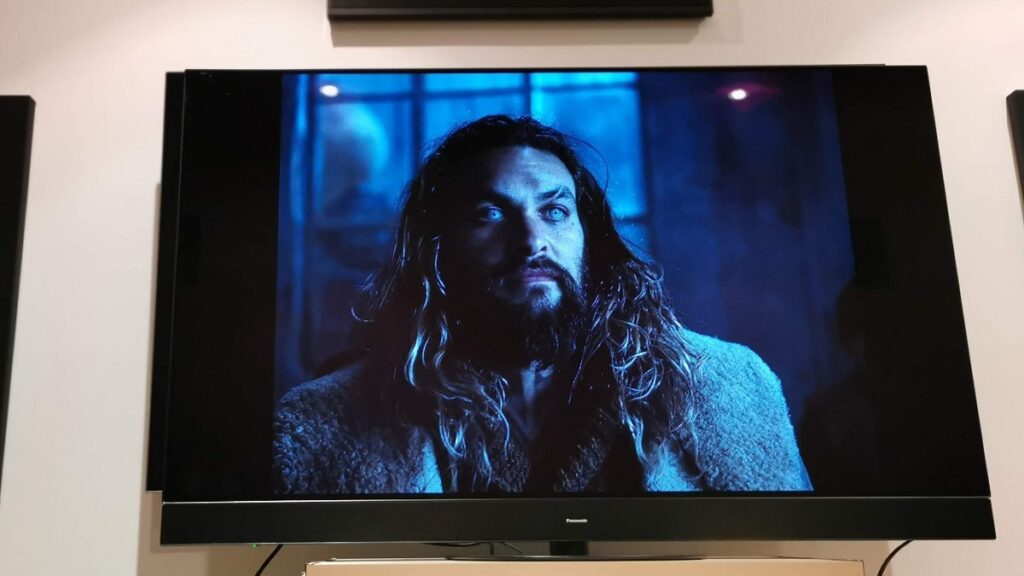
We measured HDR peak brightness, within a 5% window using the Normal picture mode, at more than 900 nits. Opting for Dynamic garners around 950 nits.
With a larger 10% measuring window, HDR peaks fall to around 830 nits. It should be remembered that the kind of specular highlights that stand out in a movie or TV show are usually small and intense, and this plays into Panasonic’s design.
As is Panasonic’s wont, fine colour tuning comes via Hollywood colourist Stefan Sonnenfeld.
There’s a richness to the set’s colour performance; it’s vibrant without ever looking overcooked. Only the over-saturated Dynamic setting goes a tad too far.
Sound quality
- Dolby Atmos 360º Soundscape Pro
Of course, the Panasonic JZ2000 isn’t just about top-class imagery. Its Dolby Atmos sound system is unusually elaborate, and on this model benefits from a Space Tune auto audio-calibration routine to help set up. A mic built into the set measures a series of multi-frequency sonic bursts.
The extended performance of 360° Soundscape Pro works really well. You get convincing Dolby Atmos height effects, while the new side-firing drivers extend width. The latter really enhances the overall listening experience, making for a much wider cinematic soundstage.
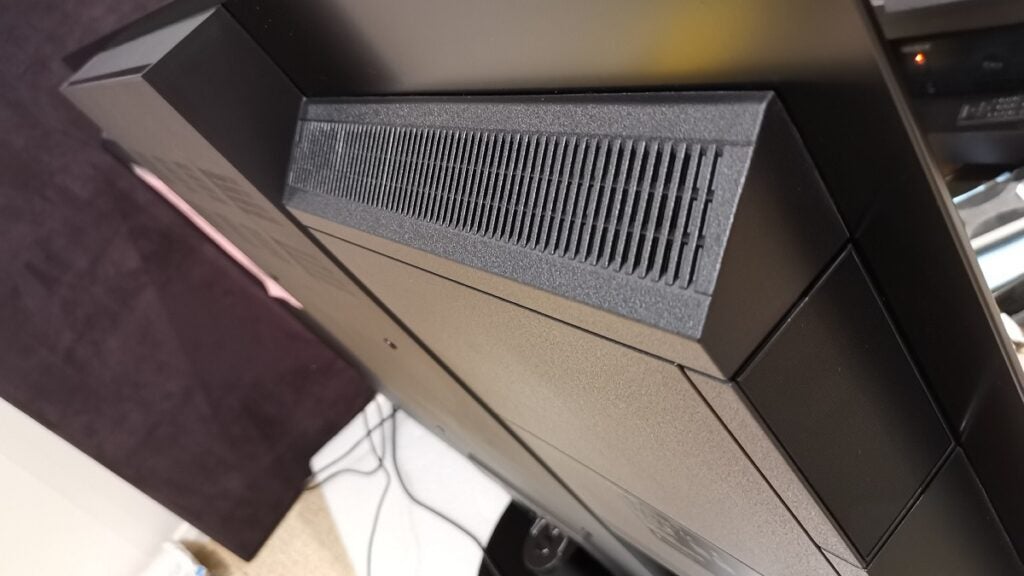
The sound is gutsy, too, with 125W of amplification more than ready for blockbuster action.
Tuning fidelity is courtesy of Technics, which goes some way to justifying its superb articulation and dialogue clarity.
Should you buy it?
You want to cover all HDR bases, and see movies as the director intended With Dolby Vision IQ and HDR10+ Adaptive, you can be sure the JZ2000 will maximise the performance of its OLED panel. It’s designed to work with, rather than around, leading dynamic HDR standards…
You Play games more than you watch movies or TV The JZ2000 may have HDMI 2.1 inputs, but if gaming is your main interest, then a LED-based screen will remove any fear of image retention from long gaming sessions…
Final Thoughts
Panasonic has pulled out all the stops with the JZ2000, and the result is a sumptuous 4K viewing experience. Picture quality is class-leading – we’re really impressed with the set’s HCX Pro AI processor, which manages to deliver extraordinary nuance and detail. And that Master HDR OLED Professional Edition certainly warrants all the fancy sobriquets. If you want to see what a movie looks like in a mastering suite, this is probably as close as you’ll ever get.
The new 360° Soundscape Pro iteration of its Dolby Atmos sound system is also quite a performer. This TV sounds larger, wider, more exciting than any 55-incher has a right to sound.
Overall, we reckon the TX-55JZ2000 warrants its ridiculous price tag – because it’s ridiculously good. This is unequivocally the best OLED TV Panasonic has ever made.
How we test
We test every TV we review thoroughly. We use industry standard tests to compare features properly and we use the tablet as our main device over the review period. We’ll always tell you what we find and we never, ever, accept money to review a product.
Tested for more than a week
Tested with a range of content
FAQs
All of them: HDR10, HDR10+, HDR10+ Adaptive, HLG, HLG Photo, Dolby Vision and Dolby Vision IQ.
With its built-in Atmos system a soundbar isn’t a requirement to go with this TV
No, the Panasonic JZ2000 only comes in 55- and 65-inch sizes.








